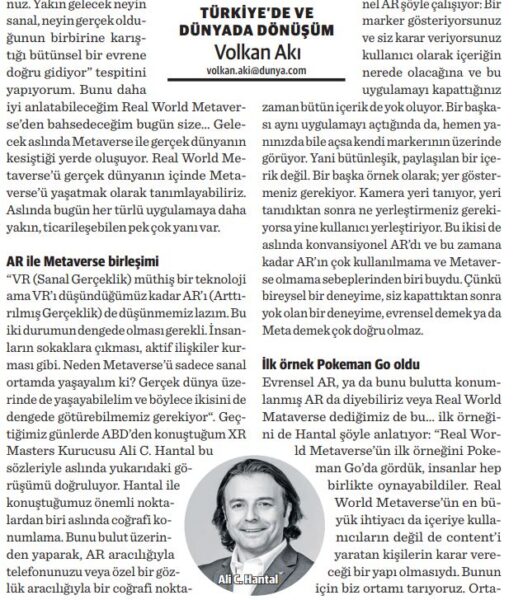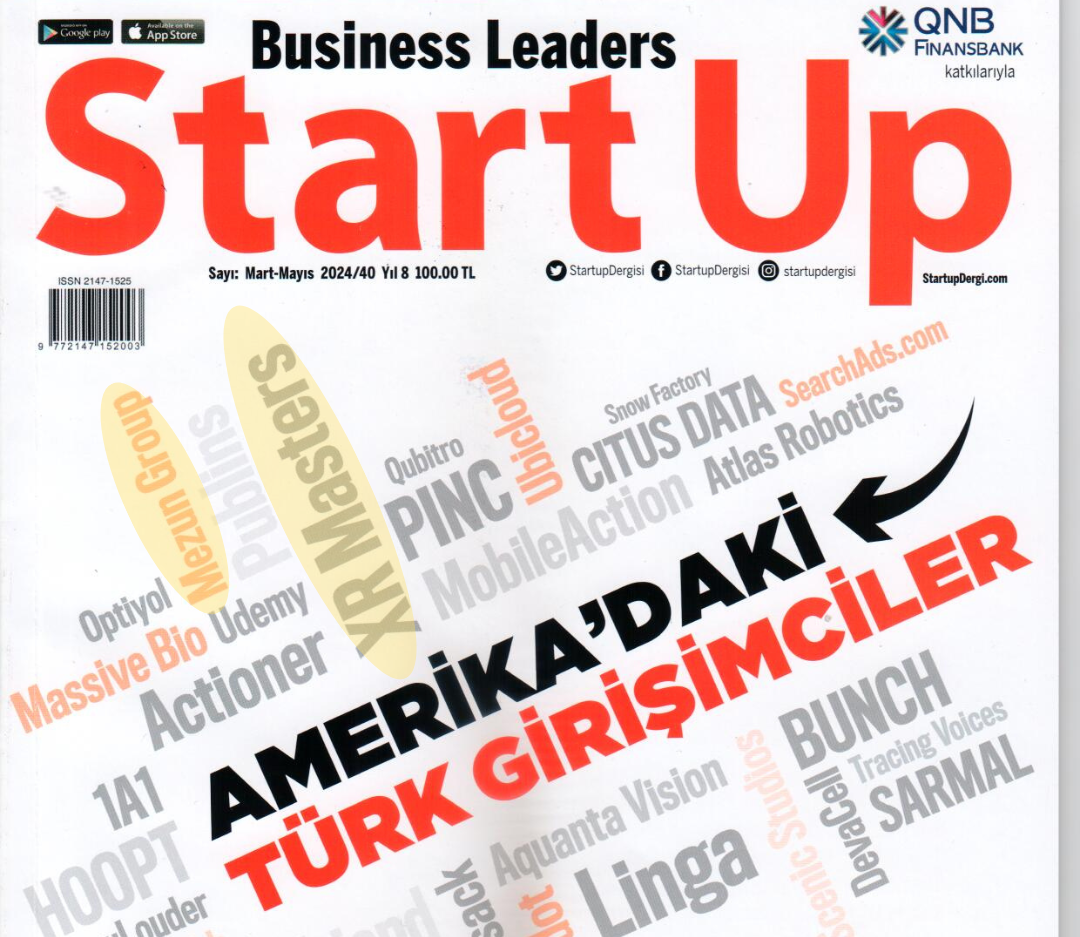Interview on Dünya Newspaper
XR-Masters CEO and Open AR Cloud Association Testbed Coordinator Ali C. Hantal, in an interview with Dünya Newspaper writer Volkan Akı, talked about the concepts of Metaverse and Multiverse, the combination of AR and Metaverse, and the required standards and protocols for the Metaverse to be open, interoperable and democratic.
Real World Metaverse and Applications
Those who follow my articles know, in these columns I have been pointing out this question: “Why do you always talk about the ‘virtual world’? The near future is heading towards a holistic universe where what is virtual and what is real are mixed together.” Today I will talk about the Real World Metaverse, where I can explain this perspective better. The future is actually formed at the intersection of the Metaverse and the real world. We can define the Real World Metaverse as keeping the Metaverse alive in the real world. In fact, today Metaverse is closer to all kinds of applications and has many aspects that can be commercialized.
Combination of AR and the Metaverse
“VR (Virtual Reality) is a great technology, but we need to think about AR (Augmented Reality) as much as we think about VR. These two technologies must be in balance. It’s like people going out of their houses, building real relationships. Why should we experience the Metaverse only in a virtual environment? We need to be able to live in the real world as well so that we can balance both”. XR Masters Founder Ali C. Hantal, whom I spoke to from the USA recently, actually confirms my above view with these words. One of the important points we talked about with Mr.Hantal is actually geopose. By doing this in the cloud, AR and VR can merge using cameras of mobile phones/tablets or headsets. This applies to everyone, meaning it is universal. For example, when you launch the application on your phone in Taksim, you can see the historical information of the place and places to visit through the camera of your phone. There are many applications like this that are developed in Turkey. Ali C. Hantal says they are currently trying to set standards in these new areas.
There are actually two Metaverses
Yes, there are actually two Metaverses, VR-based and AR-based. There are also environments where they work together. Ali C. Hantal says: “In Turkey, everybody generally talks about VR, but there is also AR. While experiencing conventional AR, one feature stands out: You determine the location of content. “Cloudless” AR (conventional AR) works like this: You point your camera to a marker and you decide where the content will be placed as the user, and when you close this app, all the content disappears. When someone else opens the same application, even if it is right next to you, they only see it on their own marker. So it’s not a persistent and shared experience. In conventional AR instead of a markers users can also point their cameras to a surface or a plane. The application recognizes the surface, and after recognizing the surface, the user can place the AR content. Both of these are actually conventional AR, and that’s one of the reasons AR hasn’t been used much and hasn’t been in the Metaverse until now. Because it would not be right to call an individual experience, an experience that disappears after you close it, universal or Meta.
The first example was Pokeman Go
Universal AR, or we can call it AR located in the cloud, AR Cloud, or Real World Metaverse. Hantal explains the first example as follows: “We saw the first example of Real World Metaverse in Pokeman Go, where people were able to play together. The biggest need of Real World Metaverse was to have a structure in which the people who created the content, not the users, are the ones who place the AR content. For this to be possible first we need to scan/capture the environment. By scanning the location, we create the digital twin of the location, which enables us to place the AR content as the ‘Publisher’ instead of users. For example, we scanned The Marmara Hotel area in Taksim Square and placed the AR content, and everyone could see, experience and take pictures of all AR objects at the same place at the same time. We placed an AR game here. In the game, it was necessary to find 10 gift boxes and detonate the fireworks. Everyone who earned 1500 points won a chocolate box from The Marmara Hotel. The one with the most points won a flight ticket sponsored by Turkish Airlines. The theme of the environment was a festival field. When one of the users taps on and detonates a fireworks box, other users can also see that interaction. It is very important that the interaction with the AR content can be experienced by everyone in a synchronous way. We can also do this with headsets”.
Geopose in the cloud
Positioning takes place in the cloud. We do it in the cloud, and that positioning is called Geopose. We actually created many experiences with Geopose. The subject that I want to draw attention to the most is what you have been talking about. I have been a member of the Open AR Cloud Association for about 2.5 years and I am actively involved. There is the HTML standard on the internet, there is URL, there is http. We send a www HTML website with hosting service to the whole world. Regardless of whether your computer is Windows or Apple, regardless of the browser you use, Explorer, Chrome or Safari, we can reach the world with a website. Moreover, whoever you are getting service from cannot dictate to you by saying “You can only go to these certain sites”. If I get service from America or from Turkey, we can go wherever we want as long as we type in www. However this is not the case with mobile applications. Because there is no such standard in mobile applications. Now at Open AR Cloud Association, we are making great efforts to establish standards and protocols for the Metaverse.
===
You can view the interview here: (*in Turkish)
https://www.dunya.com/kose-yazisi/real-world-metaverse-ve-uygulamalar/664031




